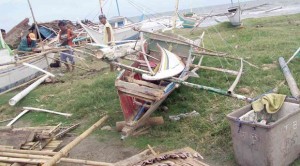Capiz reels from storm destruction

FISHERMEN in Roxas City repair their fishing boats damaged by Supertyphoon “Yolanda.” PHOTO COURTESY OF ROXAS CITY ASO
Almost three months after Supertyphoon “Yolanda” destroyed his boats, fisherman Norberto Ame has not yet returned to fishing.
“The sea is too rough and those who tried to venture out came back with damaged outriggers,” said Ame, 40, a resident of Barangay Punta Cogon in Capiz’s provincial capital of Roxas City.
Ame said he was able to repair his four motorboats but he and most of the residents have been relying on food packs since January because of bad weather.
Many fishermen and their families can only gather shells along the shoreline to eat and sell.
Roxas, known as the country’s “seafood capital” for its abundant supply of seafood, is reeling from the drop in supply of milkfish and other seafood products, as well as chicken and eggs, due to devastation of its fisheries and poultry industries.
In 2011, Capiz was the country’s top producer of milkfish from brackish-water fishponds and of oysters. It was fourth in production of mud crabs, according to the Provincial Agriculturist Office.
The price of milkfish however, has soared to P140 per kilo from P90 before the supertyphoon. “[It] … has never reached that high before,” said fishpond operator James Panaguiton.
Panaguiton, president of the Capiz Aquaculture Food Chain Group, said almost half of fishponds in the province, covering a total area of 30,000 hectares, were destroyed or damaged.
His fishponds, totaling 37 ha with about P700,000 worth of stocks, in Sapian town were among those washed out.
Fishponds in Roxas and the towns of Ivisan, Panay, Pontevedra and President Roxas were also ruined.
Most operators have not recovered from losses since many of them lack the capital to rebuild fishponds and replenish stocks.
“Fishpond operators are at a loss where to get low-interest and accessible financing. Many operate fishponds through fishpond lease agreements which could not be used as collateral in loans,” Panaguiton said.
Without financial assistance, 90 percent of those managing fishponds whose areas are 20 ha and below, could not recover, he said.
Rebuilding has become costly due to higher wages being sought by workers.
Capiz also confronts higher prices of chicken and eggs due to the massive destruction of poultry houses. Provincial veterinarian Leonel Abordo said the price of chicken has increased from P150 per kilo before the supertyphoon to P180.
Prices of eggs have climbed from P6 to P8 apiece, which could also drive up the prices of bread and pastries.
Abordo said it would take at least six months for poultry producers to recover.
But recovery is doubtful for poultry contract-grower Vicky Villagracia. “It is like starting our business from scratch after building it for many years,” she said.
Villagracia, a contract-grower of a national poultry product producer, said the typhoon destroyed her 21,000-head poultry farm in Barangay Lanot which she started in 1996. Her losses reached at least P1.5 million.
“It’s our only business which our family depends on. But nothing was left behind,” she said.
None of the contract-growers has resumed production as they struggle to build new poultry houses.
Villagracia said the cost of materials had increased significantly due to scarcity of coconut lumber.
She had to lay off her poultry manager and another employee because she could not sustain paying their wages.
The poultry growers are appealing for government assistance and low-interest loans so they can get back on their feet.
“Our common problem is that we have no collateral. It will take from a year or two to recover even if there is financing,” Villagracia said.
Amid the devastation, Capizeños have united to rebilitate the province and ensure a “disaster-resilient” development.
In a recent planning workshop held at Gerry Roxas Foundation Resources Center in Roxas, about 200 local executives, legislators, business leaders, representatives of government agencies and organizations, international humanitarian groups, and nongovernment groups suggested measures and programs to rehabilitate and develop the province.
Jose Nery Ong, executive director of the Joint Chamber of Commerces of Capiz, said that collectively drafting proposed measures was necessary so that it would represent “the common will of the various sectors of our affected communities.”
“The plan will set a sense of mission in every sector, organization and individual so we will move as one,” Gov. Victor Tanco told the Inquirer.
Among the proposals was to put up a 24/7 evacuation center in each municipality and one for the province.
Danilo So Chan, chair of the Provincial Micro, Small and Medium Enterprise Development Council, said among the main concerns of rehabilitation is how business owners can pay their existing loans and get additional funding with easy payment terms for rebuilding their businesses.
The participants agreed that the proposals would need a lot of fine-tuning and resources. But they hope that despite the massive devastation, Capizeños would rally behind their call: “Tindog (stand up) Capiz.”














